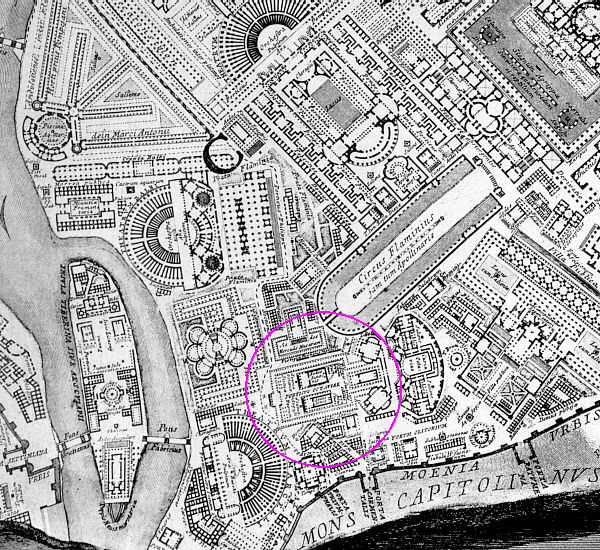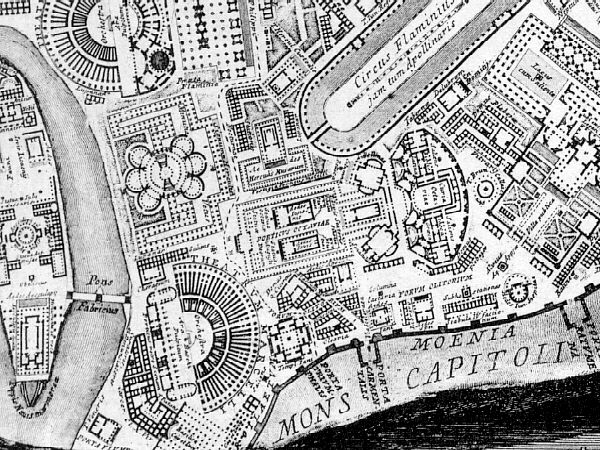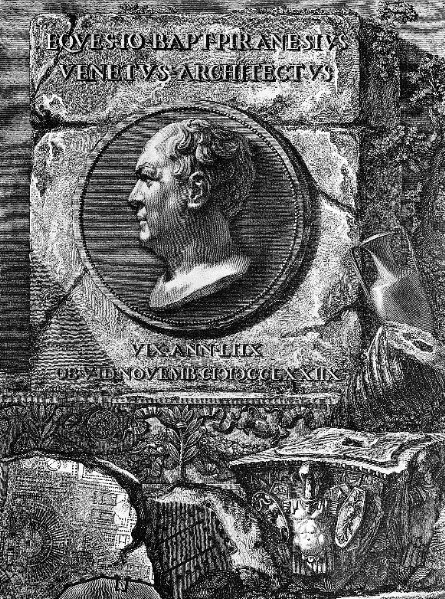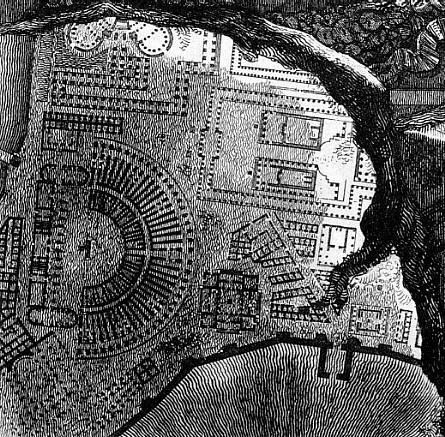Catalogo:
Porticus Octaviae (Portico d'Ottavia Sorella d'Augusto) «Plin. nel.lib. 36, al cap. 5., Sueton. in Augusto, Dion. nel lib. 55, Ovid, dell'Art, d'am, Appian. ed altri, il frammento di marmo dell'antica pianta di Roma alla Tav. 2, col num. 12, nella 3 e suo indice col num. 59.» Si dimostrano in prospettiva nella Tav. XXX e si riferiscono nel cap. 5, art. 2.
Porticus Octavia
179 BC built by Cn. Octavius
The porticus Octavia, built by Cn. Octavius in 179 B.C. to commemorate a naval victory over Perseus of Macedonia. It was also called the porticus Corinthia, from its bronze Corinthian capitals, which may have been the first instance of the use of this order in Rome. Augustus restored this porticus in 33 B.C. and placed within it the standards which he had taken from the Dalmatians. It stood between the theater of Pompeius and the circus Flaminius.
The porticus Octaviae was burned in 80 A.D. and restored, probably by Domitian, and again after a second fire, by Severus and Caracalla in 203 A.D. It enclosed a rectangular area 135 meters long and 115 wide, and is represented on the Marble Plan. It consisted of an exterior wall of brick and concrete, lined with marble, and of a double row of marble columns within. The main axis ran northeast-southwest, and the principal entrance was in the middle of the southwest side. At the four corners of the porticus were smaller vaulted entrances. Within the enclosure was a bibliotheca, erected by Octavia in memory of the youthful Marcellus, a curia Octaviae, where the senate sometimes met, and a so-called schola; but it is uncertain whether these different names were applied to the same building, to different parts of the same building, or to entirely distinct structures.
Of this porticos some ruins still remain, especially of the main entrance, which had the form of a double pronaos, projecting outward and inward. Across each front of this pronaos, between the side walls, were four Corinthian columns of white marble, which supported an entablature and a triangular pediment. The entablature and pediment and two of the columns of the outer front still exist, but the remaining columns were replaced in the fifth century by a brick arch. On the architrave is the inscription which records the restoration in 203 A.D. The height of the shaft of the columns of the pronaos is 8.60 meters, and their diameter at the bottom 1.10, and at the top 0.96 meters. Parts of a number of the columns of the south colonnade are also standing, but their bases are below the present level of the ground. Some of the capitals of these columns are built into the walls of houses in the via del Teatro di Marcello.
(Platner)
The Porticus Octavia or Octaviae was built by Cn. Octavius, the conqueror of King Perseus of Macedonia in 168 BC (Livy, xlv. 6 and 42), and was rebuilt by Augustus under the same name, as is recorded in the Ancyrean inscription -- PORTICVM AD . CIRCUM . FLAMINIUM . QVAM . SVM . APPELLARI . PASSVS . EX . NOMINE . EIVS . QVI . PRIOREM . EODEM . IN . SOLO . FECERAT . OCTAVIAM. The Porticus Octavia was close to the Theater of Pompey, but no remains of it are known to exist. It must have been an exceptionally magnificent building. Pliny describes it as being a double porticus, with doors and thresholds of fine Greek bronze. The capitals of its Corinthian columns were also of bronze. From these capitals the building was sometimes called the Porticus Corinthia; see Hist. Nat. xxxiv. 13. (Middleton)
Vincenzo Fasolo, "The Campo Marzio of G. B. Piranesi".
2691e
2691f
1956
Pagan - Christian - Triumphal Way
3123h
3123i
3123j
3123k
1999.11.21
| |


the portrait of Piranesi
1998.06.28
There is a portrait of Piranesi engraved by his son Francesco. The portrait is a profile set in a medalion, and the overall composition of the plate is in the Piranesi style. In the lower left corner, there is a stone fragment carved with plans, and it is indeed a fragment of the Ichnographia, specifically the Theater of Marcellus, the Minutia Vetus, and the Porticus Octavae. ...wonder if Francesco, or even Piranesi himself, saw the Ichnographia as Piranesi's greatest achievement. The four-sided Temple of Janus is also clearly delineated on the fragment.
...a case for the father-son theme that begins with Mars and Romulus (inversely God, the Father and His Son Jesus), and could include Augustus and Agrippa, and Trajan and Hadrian, and even Theodosius and Honorius.


|